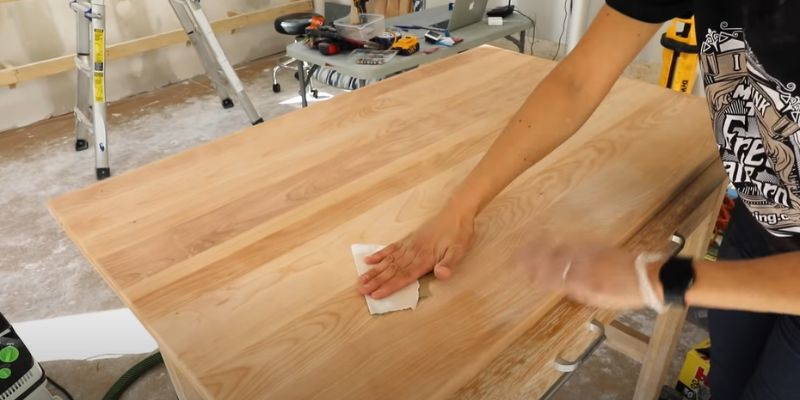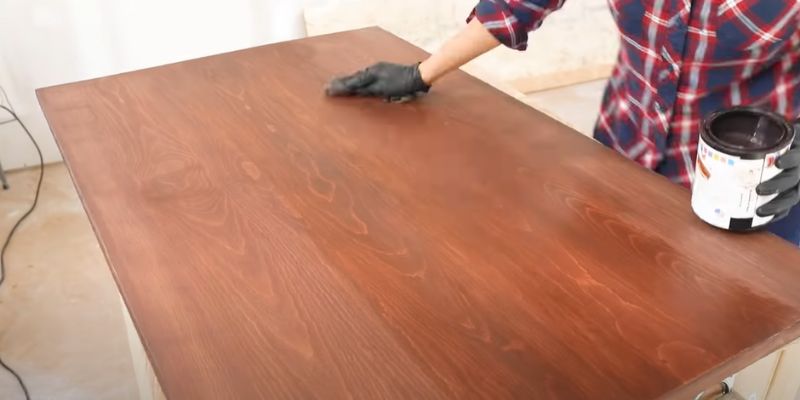To sand wood for staining, start with coarse sandpaper to remove imperfections. Then, use finer grits for a smooth finish and better stain absorption.
Sanding wood is a crucial step in the staining process, as it helps to remove imperfections, smooth the surface, and improve the wood’s ability to absorb the stain evenly. Proper sanding techniques can make a significant difference in the final appearance of the stained wood.
In this guide, we will discuss the steps and techniques involved in preparing wood for staining, including the appropriate grits of sandpaper to use and how to achieve a smooth and even surface for optimal stain absorption. Whether you’re a DIY enthusiast or a professional woodworker, mastering the art of sanding for staining will elevate the quality of your finished wood projects.
Preparing For The Perfect Finish
Before staining wood, it’s crucial to ensure that the surface is properly sanded and prepped for the perfect finish. Proper preparation not only enhances the final result but also extends the longevity of the stained wood. By understanding wood grain and types, gathering necessary tools and materials, and adhering to safety measures, you can set the stage for a flawless staining process.
Understanding Wood Grain And Types
When sanding wood for staining, it’s crucial to understand the unique characteristics of different wood types and grains. Wood grains, such as straight, spiral, and irregular, can affect the sanding process. Each type of wood, whether softwoods like pine and cedar or hardwoods like oak and maple, requires specific sanding techniques to achieve an optimal finish. Understanding these nuances is essential for achieving a smooth and uniform surface ready for staining.

Gathering The Necessary Tools And Materials
Having the right tools and materials is essential for sanding wood effectively. Equip yourself with a variety of sandpaper grits, ranging from coarse to fine, to accommodate the different sanding stages. Additionally, tools such as sanders, sanding blocks, and tack cloths are indispensable for achieving a professional finish. Quality wood stains and sealers must also be selected based on the specific requirements of the project. Gathering these tools and materials will ensure a seamless sanding and staining process.
Safety Measures Before Starting
- Wear proper safety gear including goggles, a dust mask, and gloves to protect yourself from wood dust and potential splinters during the sanding process.
- Work in a well-ventilated area to minimize inhalation of particles and fumes from wood stains and sealers.
- Keep the work area clean and free of clutter to prevent tripping hazards and ensure a smooth sanding process.
How To Sand Wood For Staining
When staining wood, proper sanding is crucial to achieving a smooth, even finish. Sanding not only smoothes the wood’s surface, but it also opens up its pores, allowing the stain to penetrate more deeply and evenly. In this guide, we’ll explore the steps involved in the sanding process to prepare wood for staining. Whether you prefer manual sanding by hand or using an electric sander, the key is to follow the right techniques for the best results.
Selecting The Correct Sandpaper Grit
Choosing the right sandpaper grit is essential for ensuring a smooth stained finish. Coarse grits such as 60-80 are suitable for initial sanding to remove rough spots, while medium grits like 100-150 smooth the surface further. Finish with fine grits such as 180-220 for a polished result. Each subsequent grit should remove the scratches left by the previous one, gradually refining the wood’s surface.
Sanding Along The Grain For Uniformity
Sanding along the wood grain helps maintain a uniform appearance, preventing swirl marks and scratches that result from sanding across the grain. This technique ensures an even surface for the stain to adhere to, creating a professional-looking finish.
Steps For Manual Sanding By Hand
When sanding by hand, begin with the coarsest grit sandpaper and progress through each stage of finer grits. Use a sanding block or sanding sponge for consistent pressure and control. Focus on areas with imperfections or uneven surfaces, and remember to sand with the grain for an even result.
Tips For Using An Electric Sander Efficiently
When using an electric sander, start with a medium grit sandpaper and gradually move to finer grits. Hold the sander firmly and move it smoothly in the direction of the wood grain. Avoid pressing too hard, as this can leave uneven patches. Remember to change the sandpaper regularly to maintain effectiveness.
Mastering Sanding Techniques
Importance Of Sanding In Stages
Sanding wood in stages is crucial for achieving a smooth and professional finish. Each stage of sanding serves a specific purpose, from leveling the surface to smoothing out imperfections. By progressing through the grits systematically, you ensure the wood is properly prepared for staining, which ultimately results in a more refined and durable finish.
Dealing With Intricate Wood Details
When working with intricate wood details, such as carved or molded features, it’s essential to pay special attention to sanding techniques. Using smaller sanding tools like detail sanders or sanding sponges allows you to reach and smooth these intricate areas with precision. By adjusting your sanding approach to accommodate the unique features of the wood, you can ensure an even and consistent finish throughout.
Avoiding Common Sanding Mistakes
- Choosing the Right Grit: Using the wrong grit can lead to uneven surfaces and patchy stain absorption. Start with a coarser grit to remove imperfections and gradually move to finer grits for a smooth finish.
- Over-sanding: Excessive sanding in one area can create unevenness or even cause damage to the wood. Practice uniform pressure and motion to avoid over-sanding.
- Skipping Grits: Skipping grits can leave behind scratches that are difficult to remove in later stages. Progress through the grits methodically for the best results.
Ensuring A Smooth Base
Before staining wood, it’s crucial to create a smooth base to achieve a flawless finish. Here are essential steps to ensure your wood is prepped for staining.
Cleaning The Wood After Sanding
After sanding, it’s imperative to thoroughly clean the wood surface to remove any dust or debris. Use a clean, damp cloth to wipe down the wood, ensuring that all the fine particles and residues left from sanding are removed.
Tackling Residual Dust On The Surface
Even after cleaning, there might still be residual dust on the wood surface. To achieve a pristine base, consider using a tack cloth to pick up any remaining dust particles. This will ensure that the wood is completely clear of any debris before applying the stain.
Using Wood Conditioner For Even Staining
Applying a wood conditioner is a vital step in the staining process, especially for porous woods such as pine, fir, or maple. The conditioner helps the wood absorb the stain evenly, preventing blotchiness and ensuring a uniform finish. Ensure to follow the manufacturer’s instructions for applying the wood conditioner to achieve the best results.

Applying The Stain Flawlessly
After sanding the wood, the next crucial step is applying the stain flawlessly. A flawless stain application can enhance the natural beauty of the wood, bringing out its unique grain patterns and depth of color. To achieve impeccable results, it’s essential to choose the right stain for your wood, master techniques for an even application, and understand how to adjust stain intensity and layering for a perfect finish.
Choosing The Right Stain For Your Wood
When selecting a stain for your wood, consider the type of wood and the desired outcome. Different types of wood absorb stains differently, so it’s important to choose a stain that complements the natural characteristics of the wood. Water-based stains are ideal for lighter woods like pine and birch, while oil-based stains are suitable for darker woods such as walnut and mahogany. Additionally, consider the color intensity and undertones of the stain to achieve the desired hue.
Techniques For An Even Stain Application
Prepare the wood surface by applying a pre-stain wood conditioner to ensure an even application and prevent blotchiness. Use a high-quality bristle brush or cloth to apply the stain in the direction of the wood grain, ensuring uniform coverage. Wipe off any excess stain with a clean cloth to prevent uneven drying and blotching. For large surfaces, consider using a staining pad or foam brush for consistent coverage.
Adjusting Stain Intensity And Layering
If the initial stain application appears too light, apply additional coats to achieve the desired depth of color. Allow each coat to dry completely before adding another layer. For a more intense color, consider using a gel stain, which provides more control over the color intensity and allows for even layering. Experiment with different staining techniques such as wiping, brushing, or spraying to achieve the perfect result.
Frequently Asked Questions For How To Sand Wood For Staining
What Is The Best Way To Sand Wood Before Staining?
To sand wood before staining, start with coarse grit sandpaper and gradually move to finer grits for a smooth surface. Sand in the direction of the wood grain to avoid scratches. Finish with a final sanding using a very fine grit sandpaper for best results.
How Do You Clean Wood Before Staining?
To clean wood before staining, start by sanding to remove old finish and smooth the surface. Then use a wood cleaner to remove dirt and grime. After cleaning, let the wood dry completely before applying the stain for best results.
How Long After Sanding Can I Stain?
You can stain right after sanding, but it’s best to wait for the wood to dry completely. Sanding removes the old finish and smoothes the surface, so the wood is ready for staining. Make sure to follow the stain instructions for best results.
Can I Stain After Sanding With 60 Grit?
Yes, you can stain after sanding with 60 grit. The coarser grit may leave deeper scratches, but staining can still be effective. Ensure the surface is smooth and free from any dust or debris before applying the stain for best results.
Conclusion
Sanding wood for staining is a crucial step in achieving a smooth and flawless finish. By following the right techniques and using the proper tools, you can enhance the natural beauty of wood while also prolonging its lifespan. Taking your time and being thorough in the sanding process will ensure professional results that you can be proud of.



6 thoughts on “How to Sand Wood for Staining: Mastering the Perfect Finish”